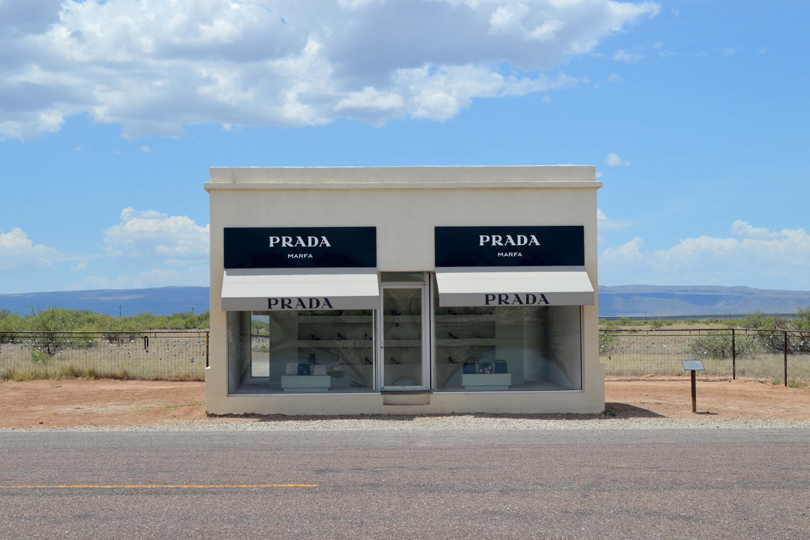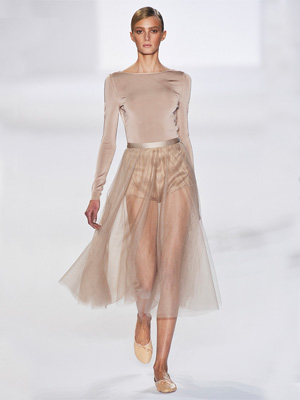By Christopher Turner
In the middle of the Chihuahua desert in Texas sits Prada Marfa, a permanent one-room art installation and faithful reproduction of a real Prada boutique. Although it houses around $80,000 worth of luxury items and looks like a boutique pulled right out of SoHo, you can’t actually shop there, because Prada Marfa has never actually opened and the doors are kept locked. Of course, that hasn’t stopped the stranded boutique in the desert from becoming somewhat of an art mecca, in the middle of nowhere, attracting thousands of visitors every single year.
The Scandinavian artist duo Elmgreen & Dragset created their Prada Marfa installation in 2005 as a commentary on commercial gentrification, intending to highlight the parasitic expansion of the luxury goods industry in North America. Originally it was meant to simply “be.” Built of a biodegradable material, the building was originally meant to slowly dissolve into its surroundings, making a statement about the transience of fashion and consumerism. If the artists had had it their way, the installation would have quietly eroded into the landscape before anyone ever really got a chance to see it.
“It would exist more as documentation and a rumour,” Dragset once said, “and at some point just disappear.”
Now you see it…now you don’t. That was the concept that came before the explosion of social media.
But as the evolution of social media drastically changed how people consume and share news and information, Prada Marfa’s future drastically changed. When platforms like Twitter and Instagram quickly rose to become the most influential apps of our generation, the art installation defied the artists’ original expectations. It weathered the elements, a legal threat and repeated acts of vandalism, and mutated into a cultural sensation that is still standing… and widely photographed for social media, especially Instagram. Here’s the history of the Prada Marfa art installation that has taken on a fashionable life of its own.
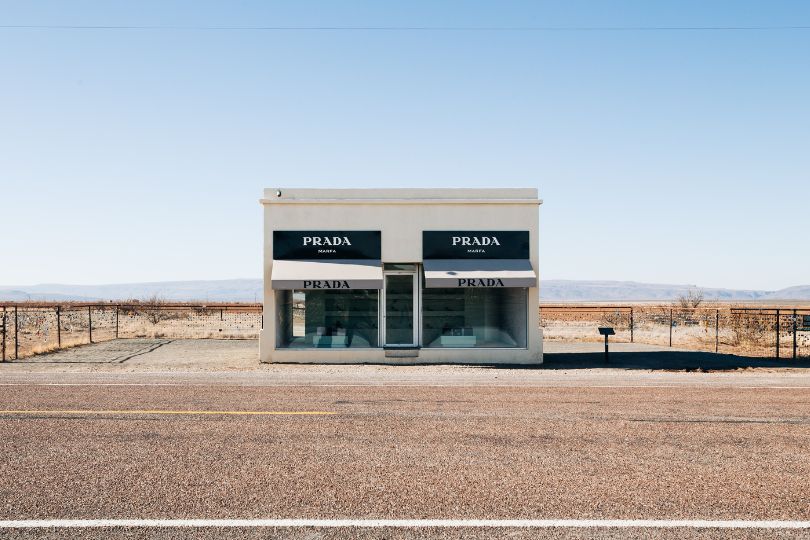
How it all started…
In 2005, the Scandinavian design team of Michael Elmgreen and Ingar Dragset set out to make a statement and create a small installation, in the form of a free-standing building – specifically, a replica of a Prada storefront. The initial idea was a response to commercialism and the high-priced luxury boutiques that were popping up and gentrifying big cities across North America.
This wasn’t the first time the artists had played around with the idea: in New York City in 2001, as expensive designer shops priced art dealers out of the SoHo neighbourhood, the duo mounted an exhibition with the words “OPENING SOON, PRADA” printed on the storefront window of the Tanya Bonakdar Gallery in Chelsea. With little else on view, collectors believed that the gallery had really closed. Opening Soon, Powerless Structures, Fig. 242was praised by art critics as a playful commentary on how art galleries have contributed to the process of gentrification in urban areas. The gallery owner, however, was not amused.
“This architectural entity of a luxury boutique had suddenly become so present in our culture, and we were all starting to get used to it,” Elmgreen said at the time.
By 2005, Elmgreen and Dragset wanted to take their idea to the next level – and putting a luxury boutique in the desert, they thought, would make the perfect statement. The piece was originally intended to be placed somewhere in Nevada – and called Prada Nevada – but the duo failed to find support in the state. They did, however, find support from two different commissioning art organizations: the New York-based Art Production Fund (APF) connected the two artists with Ballroom Marfa in Marfa, Texas, a centre of contemporary art and culture. Through Ballroom Marfa, the artists found a rancher in Texas who was willing to donate a small piece of land to the art project.
The donated land was located along US Route 90 in Jeff Davis County, Texas, about 42 kilometres northwest of the town of Marfa, and about 2.3 kilometres northwest of the small town of Valentine, which today has a reported population of under 200 and a median household income of US$45,670 (that’s approximately 17 Prada bags). Once everyone was on-board, Elmgreen and Dragset decided to name the project after Marfa because the town is known in the art world for being the one-time home of the late minimalist legend Donald Judd (1928–1994). The venue was perfect, according to Elmgreen, since “luxury brands that were using minimalism to make their interiors look more tasteful and intellectual were indebted to Judd’s work.”
Things moved fairly quickly and on October 1, 2005, Elmgreen and Dragset inaugurated a 15-foot-wide white building that had been designed with the help of the architects Ronald Rael and Virginia San Fratello. The building was made of adobe bricks, plaster, paint, glass pane, aluminum frame, MDF and carpet, with construction costing around US$120,000. Like a real Prada boutique, Prada Marfa featured the instantly recognizable Prada logos on two big black signs on the façade with two awnings underneath them, which sit overtop of the glass storefront. Through the glass you can see rows of merchandise sitting single-file on illuminated shelves set against the brightly lit pistachio green interior.
The merchandise (originally six handbags and 20 left-foot-only size-37 high-heeled shoes) was real: despite the work’s critique of her brand, Miuccia Prada, the head of the Italian luxury brand, donated purses and shoes from her fall/winter 2005 collection, which had been presented on the runway in Milan in February. The company also provided information about corporate design, from paint colours to carpet, and gave the duo permission to use the Prada trademark. (When Elmgreen and Dragset used the Prada logo in Opening Soon, Powerless Structures, Fig. 242 at the Tanya Bonakdar gallery, they did not ask permission because of the short duration of the installation.)
The night Prada Marfa formally opened, the building was broken into, the handbags and shoes were stolen, and the words “Dumb” and “Dum Dum” were spray-painted on the building’s outer walls. Ballroom Marfa, APF, and the artists made a decision to repair the sculpture, justifying the restoration because the vandalism was premature and because so few people had seen the work in its original state. Repairs happened quickly and the glass storefront was replaced with shatterproof acrylic; all of the merchandise was also replaced, another donation from Miuccia Prada. (Six identical handbags and the right-foot size-37 high-heeled shoes were displayed in place of the former left-foot shoes.) This time the replacement contents concealed a security system to alert authorities if they were moved.
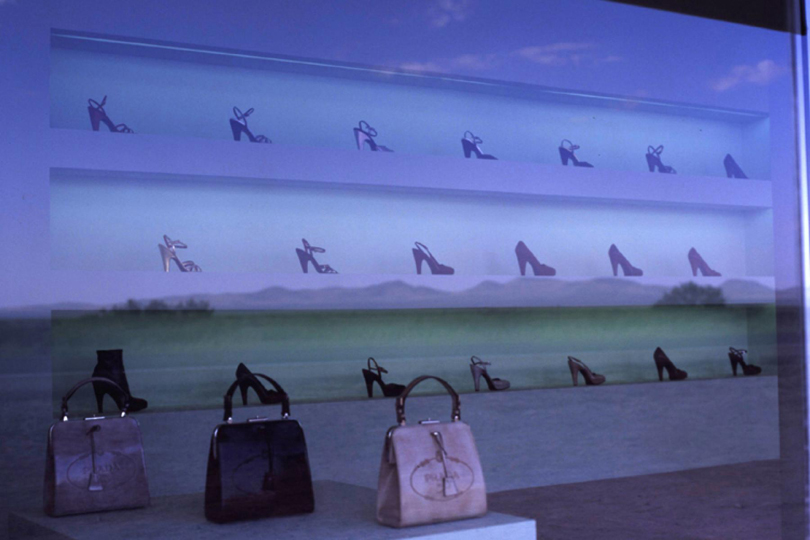
The reality of leaving Prada Marfa completely untouched instantly became a complicated and multifaceted issue. “All parties realized that if the structure were allowed to fully decay, it would become both a hazard and an eyesore,” says Ballroom Marfa’s website. So, with the blessing of Elmgreen & Dragset, the work’s original plan was modified shortly after it was constructed in 2005.
Of course, the opening night vandalism wasn’t the first time that the store would be vandalized or spark controversy.
Vandalism and legal threats
Vandalism continued, in the form of stuffed drainpipes, bullet holes in the walls and cigarette burns in the awnings. In one high-profile incident that took place in March 2014, an Austin-based artist named Joe Magnano (using the pseudonym 9271977) painted the building light blue, hung fake logos for TOMS Shoes from the awnings, plastered the building with posters and posted a political manifesto on the door. “TOMS Marfa will bring greater inspiration to consumer Americans to give all they have to developing nations that suffer disease starvation and corruption,” the pamphlet read.
The somewhat erratic and religiously themed pamphlet left in front of the building also stated: “So long as you buy TOMS shoes, and endorse Jesus Christ as your savior, welcoming the ‘white’ him into your heart. So help you God, otherwise your damned to hell [sic].” The first page ended with: “Welcome to your Apocalypse?”
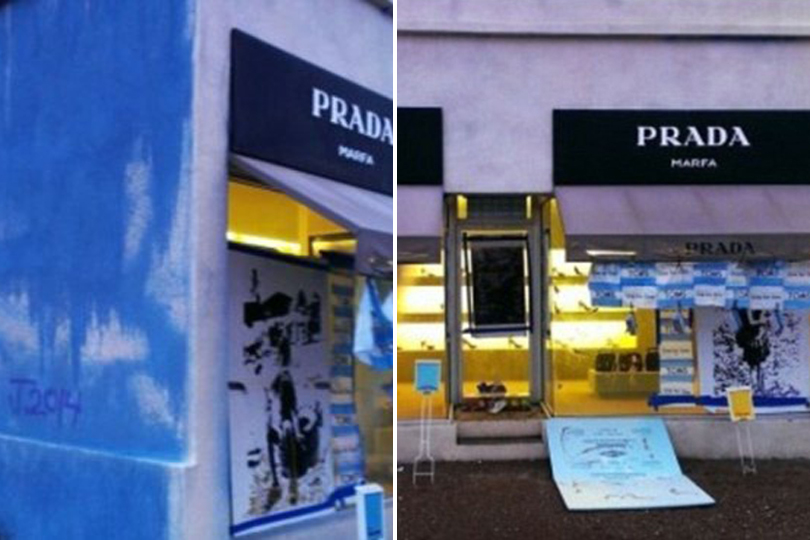
Tourists and locals were quick to get started helping to clear up the mess. The extensive damage rang in around $20,000 to repair, according to reports from The Big Bend Sentinel, a weekly covering local headlines.
The 32-year-old Magnano was arrested for using the site for his own guerrilla installation; he pled guilty to two counts of misdemeanor criminal mischief and agreed to pay Ballroom Marfa $10,700 in restitution as well as a $1,000 fine.
It wasn’t the first time the supposed-to-be-secret art installation made headlines. A year earlier, the Texas Department of Transportation (TxDOT) threatened Prada Marfa’s removal after deeming it a piece of illegal roadside advertising. According to the 1965 Highway Beautification Act, permits are required to display advertisements along a US highway on unlicensed land, and the TxDOT felt that Prada Marfa violated the specifications. Elmgreen commented on the suggestion that Prada Marfa is an illegal advertisement for Prada: “There is no company behind the artwork. It was not commissioned by Prada.… They never, ever asked me to do advertisement [sic] for them.” In September 2014, the sculpture won its right to stay when TxDOT officials announced that the structure would be granted museum status, exempting it from the signage rules.
The sculpture subsequently received extensive local and international press coverage. And then came the social media explosion.
“Prada, in the middle of nowhere?” – Marge Simpson
Thanks to consistent press coverage and a little love from social media, Prada Marfa has become a Texas landmark visited by influencers, fashion fans, and even Beyoncé and The Simpsons.
When Beyoncé swung through Marfa in early July 2012 and posted pictures from her trip on her Tumblr account (remember Tumblr?!), including one of herself jumping in front of the Prada Marfa installation, it sparked headlines around the globe and brought on cheers of joy from across the internet. It also bumped Prada Marfa’s profile considerably. Not to be outdone, a few years later, Prada Marfa made an appearance on America’s longest-running television show. In an episode of The Simpsons that aired on January 6, 2019, titled “Mad About the Toy,” the Simpson family encounters Prada Marfa in the midst of a family road trip. When Marge sees the luxury boutique on the horizon, she immediately jumps out of the car. “Prada! In the middle of nowhere?” Lisa is quick to correct her mom. “This isn’t a store at all – it’s an art installation!”
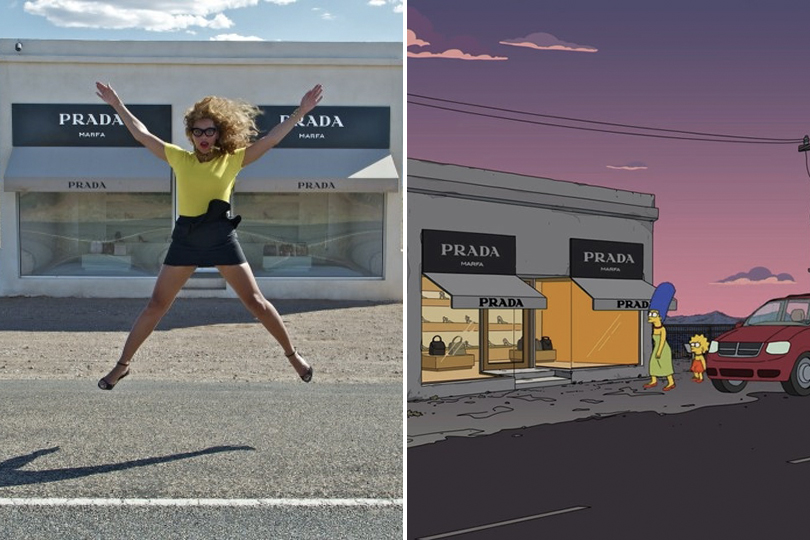
Prada Marfa also played a key role on the hit TV show Gossip Girl…well, kind of. The series ran on The CW network for six seasons from September 2007 until December 2012, and if you were a fan of the teen drama, you definitely saw the large Prada Marfa artwork that hung in the Upper East Side home of Serena Van Der Woodsen (played by Blake Lively). The backstory was that Lily van der Woodsen (played by Kelly Rutherford) purchased the artwork for the family penthouse, but more importantly, it could be spotted in countless scenes throughout the entire series oozing a sense of elitism in every way possible.
Gossip Girl was a hit with viewers, and so was the Prada Marfa sign. It helped boost the profile of the actual Prada Marfa installation and led to countless replicas of the sign, which can now be easily purchased in nearly every artwork or poster shop on the internet.
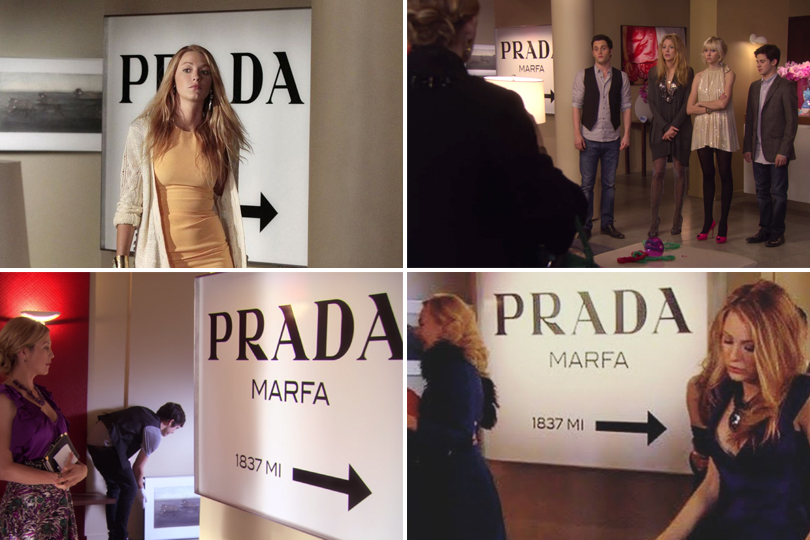
Beyoncé, The Simpsons and Gossip Girl…they all contributed to the hype, turning the once-secret installation into an online sensation and a road trip cultural landmark that is constantly visited day and night by droves of tourists. Since it’s always locked and never open, and the inside lights come on at sunset, it doesn’t matter what time of day you stop by. As Prada Marfa morphed into a tourist destination, the hype also helped turn the installation’s namesake city Marfa into a thriving tourism destination with vacation rental options, restaurants, food trucks, stores and more.
An art mecca
Today Prada Marfa has become an art mecca, attracting thousands of visitors every single year, contrary to the original expectations of the artists or their original purpose. Since it is a public installation, APF and Ballroom Marfa are required by law to perform a certain level of repairs to the structure in the interest of safety, so, to this day, the two art organizations continue to finance its maintenance, “out of respect to the residents of Valentine.” Performing this minimal maintenance also allows the installation to remain accessible to the public, contrary to the artists’ original intent.
That being said, Elmgreen and Dragset have had a change of heart in recent years. While they did give their blessing to the restorations after the initial act of vandalism, they remained fairly quiet about Prada Marfa’s budding pop culture status through the years. Finally, in 2019, they visited their Prada Marfa installation for the first time since the work’s unveiling in 2005.
“She’s grown into a grand old lady!” Elmgreen reportedly said when he saw Prada Marfa appear against the endless roadside of Highway 90. Dragset yelped: “She’s still standing!”
“Sculptures take on their own lives and we, the artists, are not in charge of them anymore,” Elmgreen said.
Road trip, anyone?

